The Wife of Bath's Prologue and Tale Contents
Romance and courtly love
Romances
Romances are so called because they were first told by troubadors in the  Romance languages of south west Europe, especially French and Provencal. After centuries of stories focused on the deeds of warriors fighting with their comrades, such as Beowulf or Roland, a Romance focused on love and a feminine perspective. The typical hero was now a solitary knight, carrying out deeds of chivalry for the sake of a lady. The wandering knight, or ‘knight errant', would be seeking an aventure in which to prove himself.
Romance languages of south west Europe, especially French and Provencal. After centuries of stories focused on the deeds of warriors fighting with their comrades, such as Beowulf or Roland, a Romance focused on love and a feminine perspective. The typical hero was now a solitary knight, carrying out deeds of chivalry for the sake of a lady. The wandering knight, or ‘knight errant', would be seeking an aventure in which to prove himself.
The Arthurian tales
The stories of King Arthur's Knights of the Round Table are typical tales  of chivalry. Earlier Arthurian tales were male-centred epics, but by the time Chretien de Troyes wrote his French romances, such as Lancelot and Yvain, towards the end of the 12th century, the hero had to be a single knight on a chivalric quest.
of chivalry. Earlier Arthurian tales were male-centred epics, but by the time Chretien de Troyes wrote his French romances, such as Lancelot and Yvain, towards the end of the 12th century, the hero had to be a single knight on a chivalric quest.
Significantly, the greatest knights were also tragic lovers – consumed with adulterous passion for the wife of someone of higher rank:
- Lancelot's love for Queen Guinevere divides him from his lord and master, Arthur, and leads to the dissolution of the Round Table
- Tristan's love for Isolde, the wife of King Mark of Cornwall, results in their deaths.
Chaucer and courtly love
By the time of Chaucer, in the late fourteenth century, the ethic of courtly love was not taken too seriously – if it ever was:
- Amongst The Canterbury Tales, whilst The Knight's Tale employs elements of the courtly tradition, those told by the Miller and the Merchant are parodies of courtly love situations, in middle class settings
- The Tale of Sir Thopas is a witty parody of romances involving a knight errant in search of an ‘aventure'
- The Franklin's Tale comes closest to a tale of courtly love, indeed Chaucer claims it is based on an old Breton ‘lay', but it differs from the typical romance in that the lady and her husband are deeply in love with each other – which is the basis of the Tale's ingenious plot.
Romance and the Wife of Bath's Tale
Sometimes the Wife's Tale is referred to as a Romance and the question is raised about whether or not this kind of tale is appropriate to the earthy (and, in the modern sense of the word, ‘unromantic') Wife:
- Her opening words are typical of the genre, but she then subverts it by making her young knight an un-chivalrous rapist
- The knight's quest to please the impossible demands of a queen is to be expected, but not the resulting servitude to an ugly old woman
- The sermons which obtrude into the text actually question the whole convention of chivalry
- The reader's expectations of a courtly tale in which women are rescued by men (knights) is overturned – it is a powerful woman who rescues a powerless man
- The fairytale transformation at the end is only achieved on the woman's terms.
Recently Viewed
Related material
Scan and go
Scan on your mobile for direct link.